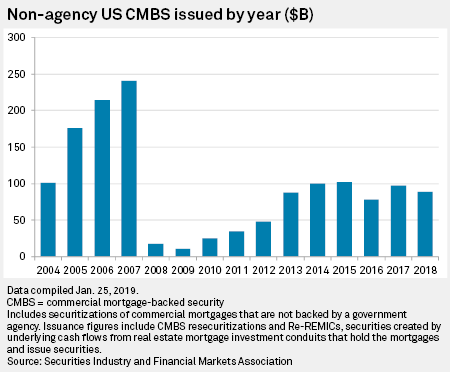 Issuance of U.S. commercial mortgage-backed securities is expected to remain largely flat year over year in 2019, as CMBS lenders face competition from other capital sources and investors look further out on the risk spectrum for yield.
Issuance of U.S. commercial mortgage-backed securities is expected to remain largely flat year over year in 2019, as CMBS lenders face competition from other capital sources and investors look further out on the risk spectrum for yield.
There were roughly $78.4 billion of U.S. conduit and single-asset, single-borrower CMBS
The underwriting of real estate securitizations has been an important business for some investment banks. According to Commercial Mortgage Alert, the top book runners for U.S. CMBS through the first three quarters of 2018, accounting for more than 40% of the market, were units of JPMorgan Chase & Co., Deutsche Bank Securities Inc., Goldman Sachs Group Inc., Wells Fargo & Co. and Morgan Stanley. Units of Wells Fargo and J.P. Morgan were the top CRE CLO book runners for the period, accounting for nearly 75% of the market.
The CRE CLO market, in its current form, revolves around floating-rate loans with higher yields and shorter durations than typical CMBS loans, and its comeback during a flat period for CMBS suggests that bond investors are gravitating to a product that can pay higher returns while holding value in a rising-rate environment. The higher yields come in exchange for higher risks, though, because the real estate properties underlying the CLOs typically do not have the stabilized cash flows of the properties underlying CMBS.
At a commercial real estate finance conference in January, lending industry leaders said they viewed the U.S. economy and real estate as stable, though many described their outlook as guarded, and most predicted that real estate values would fall or remain the same in the coming year. They also described an environment crowded with lenders of various types, including banks, private debt funds, insurance companies and CMBS conduit lenders — all seeking to finance a relatively limited number of properties.
A lack of loans coming due in 2019 could also contribute to lower volume, Morningstar Credit Ratings analyst Steve Jellinek said in a note. CMBS loans typically have a 10-year duration, and a decade ago, the global financial crisis laid waste to the new issuance market for CMBS. While more than $80 billion in CMBS loans matured in each of 2016 and 2017, only $10.75 billion matured in 2018, with a combined $34.65 billion expected to mature in 2019 and 2020, Morningstar said.
Rise in single-asset
Despite the decline in refinancing opportunities, S&P Global Ratings analyst James Manzi said in an interview that the rating agency expects CMBS issuance in 2019 to be roughly similar to the 2018 total.
A greater share of CMBS deals in 2018 were single-asset, single-borrower transactions, in which a large loan, often backing a single highly valued property or single borrower's
 |
Of its $80 billion issuance forecast for 2019, S&P Global Ratings predicts that roughly half will be conduit deals and half will be single-asset, single-borrower — an increase from the proportion of single-asset transactions in 2018.
Some investors favor single-asset deals because the underlying assets tend to be institutional-quality "trophy" real estate and relatively easier to evaluate. Moreover, Trepp LLC analyst Joe McBride noted, many single-asset deals, such as the recent securitization of a loan backed by part of The New York Times Co.'s headquarters in Manhattan, N.Y., involve floating-rate loans that protect debt investors against rising interest rates.
McBride said in an interview that with real estate property values relatively high after years of growth, more asset managers are shifting toward debt investments and away from equity, given the lower downside risk associated with debt.
Split in investor demand
In the crowded field, some debt investors have continued to prize higher-quality properties, even at lower returns, while others have looked elsewhere, and away from CMBS.
"The pension funds, insurance companies, banks — the lower-risk type of investors — are going to be really fighting for those higher-quality loans," McBride said. In turn, because yields for relatively stable properties are low, lenders that target higher returns — such as hedge funds and private debt funds — are turning to more marginal borrowers.
"With values where they are, being at all-time highs for those income-producing, stabilized properties, I think investors are having to move up the risk scale, [toward] transitional properties, properties that need renovation, properties that have lost a big tenant and need time to re-tenant the space or fix up the space," McBride said.
Those are the types of properties typically backing the loans securitized in CRE CLOs, he added, and their higher yields are key to the asset class' recent popularity.



